Infected Tongue Piercing: Signs, Causes, And Prevention
Explore safe ways to care for and flaunt your newly pierced tongue.
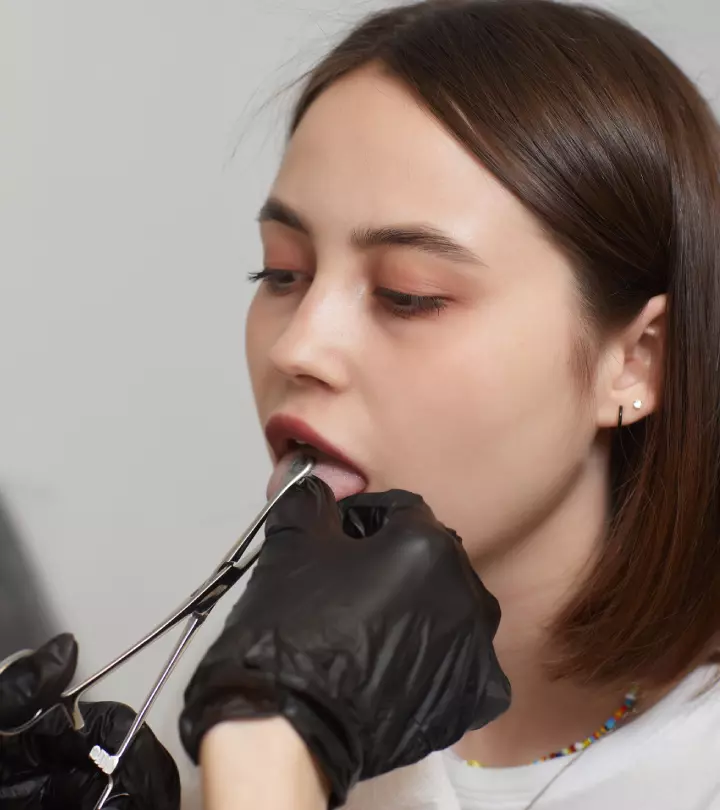
Image: Shutterstock
Tongue piercings have been popular since the punk era of the 1980s as they add a unique edge to your personality. But did you know that the possibility of an infected tongue piercing is extremely high? Before you can show off your trendy new tongue embellishment, you must take care of the piercing, as it is prone to bacterial infections until fully healed. Typically, tongue piercings heal within 4-6 weeks if properly cared for. However, the healing process may take longer in the case of an infection, which can be extremely uncomfortable (1). This article will guide you on how to spot and treat an infected tongue piercing and when to seek medical attention. Scroll down to learn more.
In This Article
Signs Of An Infected Tongue Piercing
Despite ensuring a safe tongue-piercing procedure, signs of infection may still develop and worsen if you do not notice and treat them early on. An infected tongue piercing will show the following signs and symptoms (2):
1. Swelling
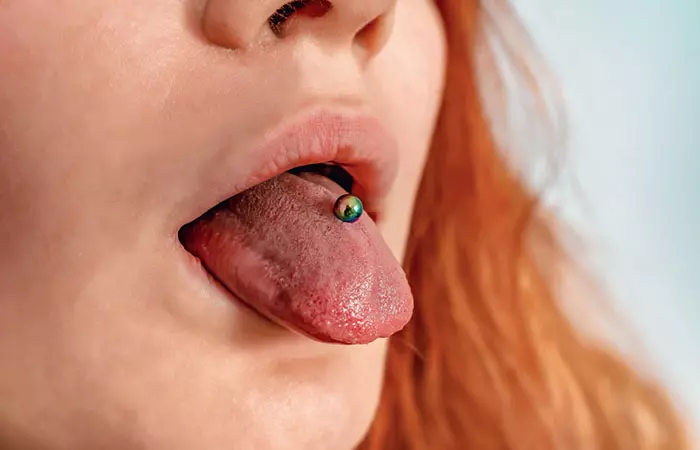
A swollen tongue is one of the common signs of an infected tongue piercing (3). You may notice tiny piercing bumps that may get bigger. Although it is common to experience some swelling for about a week after a tongue piercing, it could be serious if persists and keeps swelling beyond a week.
2. Throbbing Pain

Swelling is often accompanied by a throbbing pain in cases of tongue piercings (4). It may cause discomfort while closing the mouth or trying to speak, drink, or eat. Normally, the pain should subside within a week of piercing. If it lasts longer than that or increases in intensity, it could indicate an infection.
3. Redness
View this post on Instagram
Redness may occur on the tongue due to friction while trying to eat or speak with a fresh piercing. This indicates a strain on blood vessels caused by the piercing ornament. You may also observe the area around your piercing becoming redder than the rest of your tongue. This means that your tongue is still sore or that the infection has started.
4. Pus Discharge
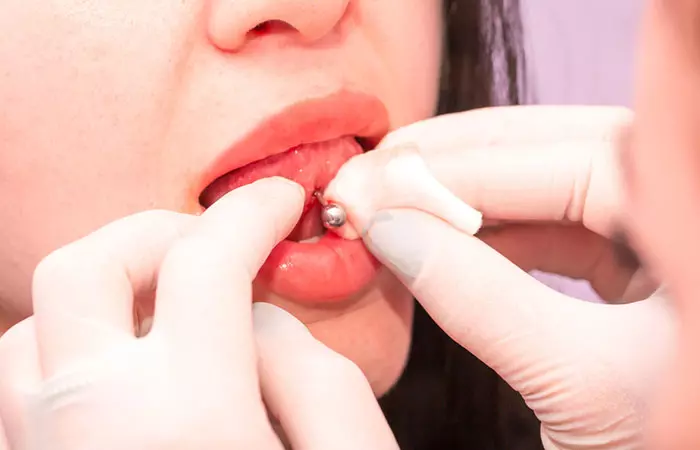
An infected piercing can also lead to yellow, green, or whitish discharge oozing out of the pierced site. The pus can form a thick crust, which can cause itchiness and further inflammation at the piercing site. Its persistent presence can slow down healing time.
5. Bleeding
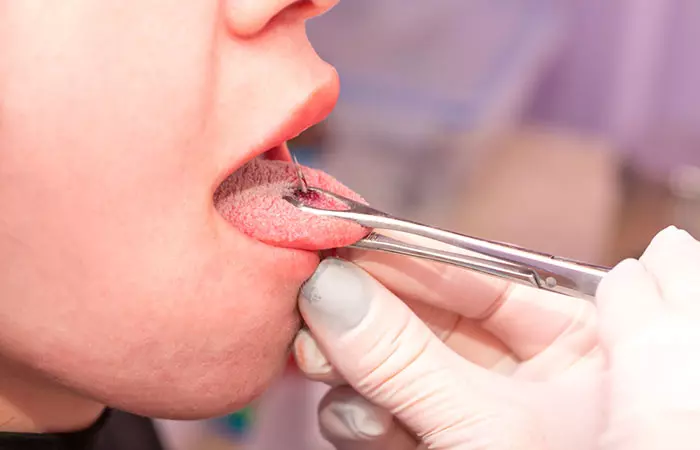
Bleeding is another symptom of an infected tongue, which can occur when the piercing is not healed properly and the skin tissues around the piercing have severe inflammation. This can lead to a rusty taste in the mouth. Recurrent bleeding may lead to significant blood loss and also cause or aggravate painful ulcersi A sore or open wound on the skin or mucous membrane with the loss of tissue, often accompanied by pain and inflammation. and inflammation (2).
Briana, a fashion and lifestyle vlogger shares her experience with her infected tongue piercings, which she claims were caused due to bad oral hygiene and aftercare practices. Alongside severe pain and bleeding, she also experienced pus discharge. “It was like whitish-yellow, and it was coming out of one of the holes, you know where my piercing was. The hole was like oozing pus. You can’t taste it but you can see it (i),” she elaborated on how it looked and said that is how she knew how bad the extent of the infection was.
Along with the major signs mentioned above, you may experience some other symptoms like (2):
- Fatigue
- Fever
- Shivers
- Tenderness
- Difficulty in breathing
- Difficulty in speaking
- Pain in the neck region
All these side effects may differ in severity from person to person, but they can lead to serious complications if not taken care of properly. That is why it is important to be aware of the possible factors causing such tongue piercing infections. Learn about them in the following section.
Key Takeaways
- If you notice swelling, redness, pus, bleeding, and throbbing pain at the tongue piercing site, your piercing may be infected.
- Poor oral hygiene, weakened immune system, and unclean piercing conditions are some of the culprits behind tongue piercing infections.
- Manage your tongue piercing properly by rinsing your mouth with antibacterial mouthwash after every meal, eating soft foods, and avoiding playing with the piercing.
- Before getting a tongue piercing, do your research and select a reputable piercer, maintain oral hygiene, and opt for hypoallergenic jewelry to lower the chances of infections.
Causes Of An Infected Tongue Piercing
All piercings run a high risk of infections due to bacterial exposure. Besides that, anything from the process, to your lifestyle habits, could be responsible for an infection. Explore a few common reasons.
1. Poor Oral Hygiene
A history of tooth cavity paired with general negligence in oral hygiene is one of the most common causes of tongue piercing infections. The warm environment of the mouth makes it a cozy spot for bacteria to multiply. Further, the persistent presence of plaque may cause gum diseases, which can worsen the bacterial infection on the tongue piercing site (2). So make sure you brush, floss, and rinse your mouth with an antibacterial mouthwash regularly to ensure good oral hygiene. Also, clean your tongue piercing with sterile saline solution 2-3 times a day to get rid of any stuck food particles and bacteria.
 Trivia
Trivia2. Weak Immune System
The immune system plays a significant role in healthy wound healing (5). An infected tongue piercing is far from a trivial issue if your immune system cannot fight the bacterial invasion. In such a case, the contamination of the piercing wound may quickly escalate to fever and chills, prolonging the healing period and making it extremely distressful to manage.
3. Unhygienic Piercing Conditions
The tongue piercing procedure generally involves using a 14 gauge needle, to pierce the chosen site. These needles must be newly out of their package to guarantee a safe piercing experience. If the piercing parlor does not prioritize safe practices like sterilizing the equipment or sanitizing the premises, it encourages bacterial infections. Additionally, a used needle may be contaminated with infected blood, leading to bloodborne diseases, which can even escalate to death in extreme cases (1). So, do look around the premises to ensure the establishment takes adequate hygiene measures.
4. Touching Your Piercing
Touching your piercing with dirty hands can introduce bacteria to it. Constant playing with the jewelry may even reopen the wound and stretch the initial healing period, increasing the risk of inflammation, which may worsen the complications of your tongue piercing.
5. Improper Piercing Jewelry
, a professional body piercer, says, “Failing to clean the piercing area properly and using a thick or inappropriate dressing can allow bacteria to enter the wound. Consult your piercer for the correct aftercare tips and follow them to keep the area clean and let the wound heal quickly.”
Once you have noticed the signs of spreading infection on your tongue, it is important to manage them. There are a lot of simple tips covered in the next section that will help prevent it from worsening.
How To Treat An Infected Tongue Piercing
These are a few hacks you can adopt to manage a tongue piercing infection:
- Stick To Soft Foods
Switch to a diet of softer foods like porridge, yogurt, mashed potatoes, or soup. It minimizes movement in the area and helps soothe the infected tongue tissue. Stay away from salty, spicy, or acidic foods to avoid irritating the pierced site. - Use A Mild Mouthwash
Opt for a non-irritating, alcohol-free, antibacterial mouthwash rinse after every meal and before bed to kill germs and bacteria that may remain even after brushing (6). Doing so creates hygienic oral conditions for healing and helps reduce the ongoing risk. Since your oral cavity is a perfectly moist environment to host bacteria, it is important to do daily cleansing. You should also clean the site of piercing with a saline solution to prevent bacterial growth on the open wound. - Stick To Soft Foods
Switch to a diet of softer foods like porridge, yogurt, mashed potatoes, or soup. It minimizes movement in the area and helps soothe the infected tongue tissue. Avoid salty, spicy, or acidic foods to avoid irritating the pierced site. - Do Not Mess With The Piercing
Control the urge to play with your intraoral piercingi A piercing that occurs inside the oral cavity. or moving it around too much, especially with dirty hands, as it may transfer bacteria to the site. Doing so may also open up the wound and cause recurrent bleeding. - Apply Ice On The Swelling
If your tongue is swollen, applying ice chips or a cold compress may help reduce the swelling (1). However, don’t apply ice directly, as it may be too cold and damaging for delicate tongue tissues. Use a clean cloth or towel for a barrier. Ice cream may also help but remember to clean your mouth afterward to avoid bacteria buildup. - Take Over-The-Counter Pain Relievers
Ask for over-the-counter pain relievers prescriptions from a doctorl to manage the pain from the piercing infection. Make sure they medicines do not interfere with any other medications you might be taking. - Drink Plenty Of Water
Ensure you drink ample water to treat the tongue piercing infection. Hydration aids in flushing out toxins, promoting overall bodily fluid circulation. Increased water intake helps the body produce more saliva (7). Saliva is a natural antimicrobial agent that aids in preventing and combating infection (8). So, sip up to maintain your body’s natural defenses.
An infected tongue piercing requires proper and diligent care to heal quickly. Check out the next section to understand how long it may take.
How Long Does It Take For An Infected Tongue To Heal?
With infected tongue piercings, there are some common stages of healing. At first, you may experience painful ulcerations that persist for some time and disappear within 3–5 weeks (2). After that, you may experience local inflammation, which usually starts after 3-4 days of piercing. This inflammation might stick around for some more weeks, possibly leading to granulomatous inflammationi The formation of small, grain-like structures in tissues, often in response to inflammation or infection. .
The healing period can differ from person to person, so it is important to keep a close eye on how you are feeling and stick to the right aftercare routine. If things do not improve, reach out to a medical professional immediately for a safe recovery.
Although there are some good treatment methods to manage tongue piercing infections, there are also multiple care tips to follow before your piercing appointment and after getting your tongue pierced, that will help you prevent infections and ease the recovery process. The following section sheds some light on them.
How Can You Prevent Tongue Piercing Infections?
You need to be very careful with your piercing for the first week, as the fresh wound is the most delicate during that time. By following these steps, you will be able to heal it with minimal issues. Follow these tips for at least a six-week healing period to lower the risks.
- Start by choosing a trustworthy piercer who uses sterile equipment and is committed to ethical business practices. Avoid unlicensed persons completely.
- Take their aftercare advice seriously and follow the best oral hygiene practices, ensuring a clean and healthy healing process.
- Clean your mouth by brushing and rinsing with mouthwash before a piercing appointment to get rid of stuck food particles.
- Avoid sharing utensils or food with others to prevent the spread of bacteria.
- Do not consume very hot beverages, alcohol, and acidic foods. Also, avoid hard, crunchy, sticky, chewy, and spicy foods as they may irritate the skin.
- Avoid smoking or chewing tobacco, as they can irritate the piercing and hinder recovery (9).
- Avoid kissing and oral sexual activities to prevent the introduction of new bacteria to the unhealed piercing (9).
- Avoid touching the piercing too often as it can transmit harmful bacteria to the site.
- Avoid wearing piercing jewelry made from cheap acrylics or nickel, as they can cause allergic reactions, thus increasing the risk of infection (2).
- Make sure you regularly inspect the piercing for any signs of irritation. Early detection can help you address issues before they escalate into infections.
- Remove your jewelry for some time after it is fully healed to clean out your piercing. The persistent presence of tongue jewelry can hinder cleaning and lead to bacteria buildup.
 Pro Tip
Pro TipWith the adherence to infection control guidelines discussed above, you can minimize your risk of developing a tongue-piercing infection. Keep reading the next section to learn how following a thorough oral routine can help heal your tongue piercing.
Importance Of Maintaining Oral Hygiene After Getting A Tongue Piercing
Maintaining proper oral hygiene after getting a tongue piercing is crucial to prevent infections and promote healing. The mouth harbors a variety of bacteria, and without proper care the piercing site may become infected. This can lead to swelling, pain, or more serious complications.
Dentists recommend rinsing the mouth with a non-alcoholic, antibacterial mouthwash after meals. You should avoid smoking and drinking alcohol, as these habits can irritate the wound. Brushing and flossing regularly, as well as cleaning the piercing with a saline solution, helps minimize bacterial growth.
Good oral hygiene also reduces the risk of damaging teeth or gums, which can occur from improper care or unclean jewelry.
Tongue piercings add a cool and edgy touch to your personality, but they also require careful aftercare. Improper care can increase the chances of infection. Thus, you should be able to recognize and address the signs of infection, like persistent swelling and pain, redness, oozing pus, and excessive bleeding. An infected tongue piercing can be managed with regular mouthwash rinses, a soft food diet, and good hygiene practices. It is also advised to go for hypoallergenic jewelry for the initial piercing to lower the risk of infection. If you face any difficulty during the healing process, reach out to your piercer or a medical professional immediately.
Frequently Asked Questions
Is a tongue infection serious?
Yes, a tongue infection can be serious. If left untreated, this may worsen complications of tongue piercings, such as the spread of bacterial infection and symptoms of abscessi A collection of pus within tissues, usually caused by a bacterial infection. es in patients. This may damage the soft tissues of the tongue, cause dental trauma, and make speaking or breathing difficult. It is important not to overlook the signs and symptoms of such a piercing infection in the initial healing period, as it may lead to periodontal diseasei Inflammation and infection of the tissues surrounding and supporting the teeth. and severe tongue damage (6).
Does apple cider vinegar help infected piercings?
Apple cider vinegar is too harsh an ingredient to use on an infected piercing. As a consensus, you should avoid putting anything in your new piercing that you would avoid putting in your eyes. A sterile saline solution is the only acceptable cleaning solution for piercings. If the infection gets worse, it is best to reach out to your piercer or healthcare provider.
How do you know if your tongue piercing is rejecting?
If you notice increased soreness, migrationi In a piercing, it refers to the shift of the pierced hole from its originally targeted place. of the jewelry towards the surface, or some inflammation at the site of the piercing hole, your piercing might be rejecting (10). This happens because your immune system views the piercing as a foreign body and wants to push it out. If you suspect your tongue piercing might be rejecting, consult your piercer for evaluation or jewelry adjustment.
Preventing piercing infections is possible with simple DIY remedies. However, there are a few things that you need to be mindful of. Watch the following video to learn tips to ease your tongue piercing healing and avoid a tongue infection.
Personal Experience: Source
StyleCraze's articles are interwoven with authentic personal narratives that provide depth and resonance to our content. Below are the sources of the personal accounts referenced in this article.
(i) Storytime: My Scoop Piercing Got Infected!!https://youtu.be/KbCCN_lKB5c?si=UP2EKOnka3AM-Ir6
References
Articles on StyleCraze are backed by verified information from peer-reviewed and academic research papers, reputed organizations, research institutions, and medical associations to ensure accuracy and relevance. Read our editorial policy to learn more.
- Oral Piercing: A Pretty Risk—A Scoping Review of Local and Systemic Complications of This Current Widespread Fashion
https://www.ncbi.nlm.nih.gov/pmc/articles/PMC10177791/ - Oral and Perioral Piercing Complications
https://www.ncbi.nlm.nih.gov/pmc/articles/PMC2606659/#R10 - The Consequences of Tongue Piercing on Oral and Periodontal Tissues
https://www.ncbi.nlm.nih.gov/pmc/articles/PMC3926233/ - Oral Complications Associated with the Piercing of Oral and Perioral Tissues and the Corresponding Degree of Awareness among Public and Professionals: A Systematic Review
https://www.ncbi.nlm.nih.gov/pmc/articles/PMC10647284/ - The Innate Immune System in Acute and Chronic Wounds
https://www.ncbi.nlm.nih.gov/pmc/articles/PMC4742992/ - Bacterial infections complicating tongue piercing
https://www.ncbi.nlm.nih.gov/pmc/articles/PMC2852294/ - The relationship between dehydration and parotid salivary gland function in young and older healthy adults
https://pubmed.ncbi.nlm.nih.gov/9310086/ - The power of saliva: Antimicrobial and beyond
https://www.ncbi.nlm.nih.gov/pmc/articles/PMC6855406/ - Development of a Tongue-Piercing Method for Use With Assistive Technology
https://www.ncbi.nlm.nih.gov/pmc/articles/PMC4445083/ - Body piercing
https://www.ncbi.nlm.nih.gov/pmc/articles/PMC1127091/
Read full bio of Ikramul Haque Shazib
Read full bio of Aparna Harry
Read full bio of Anjali Sayee
Read full bio of Gracia Odile





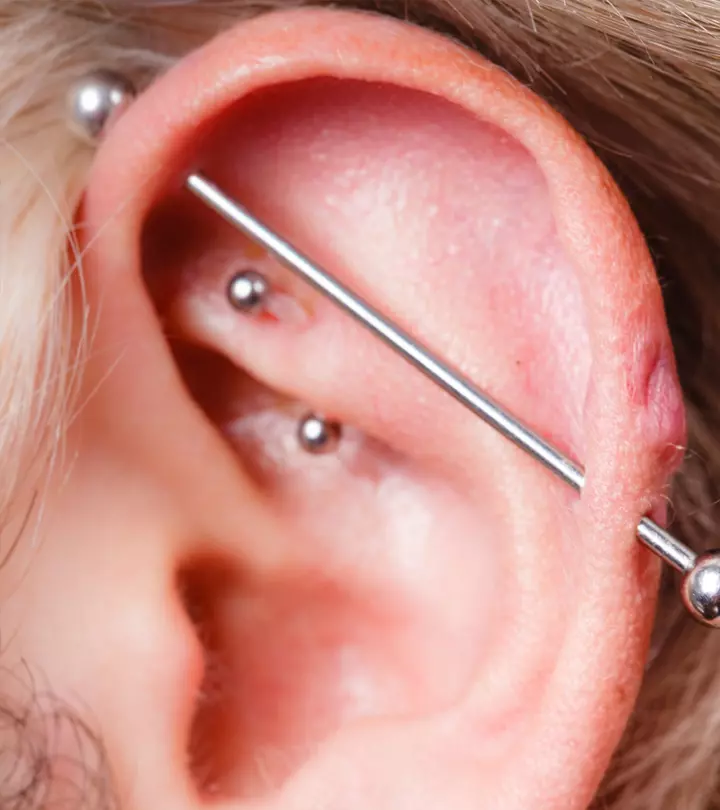








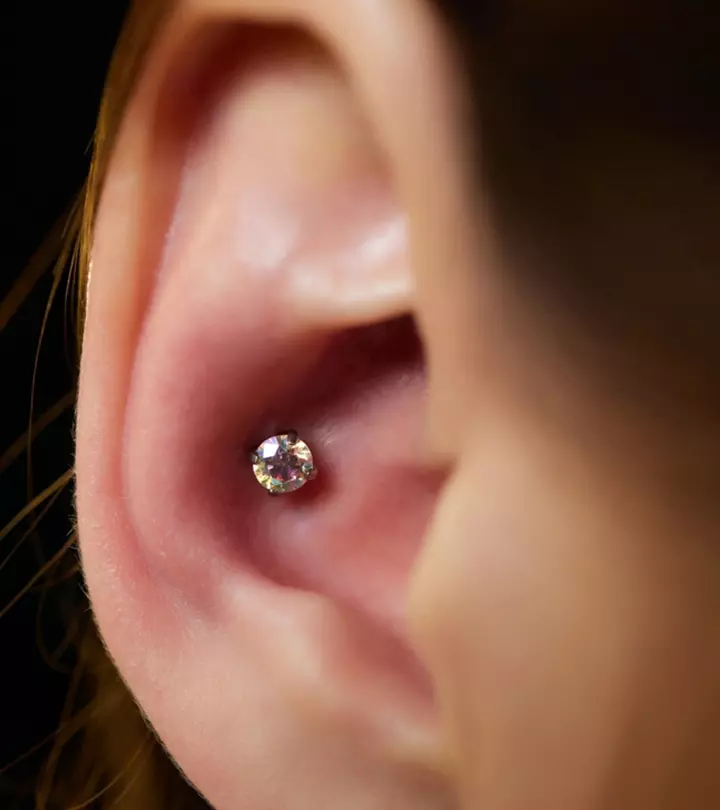










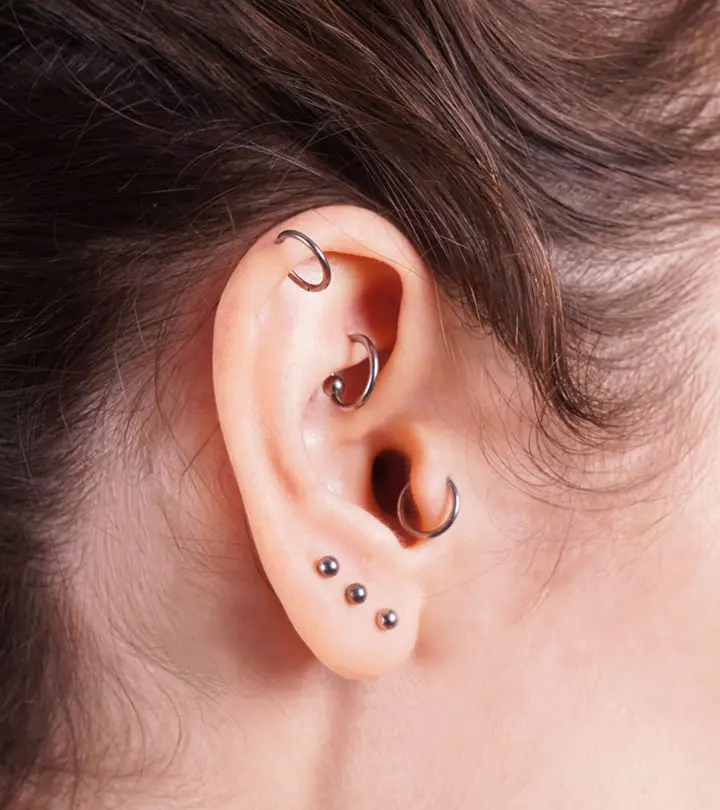
Community Experiences
Join the conversation and become a part of our empowering community! Share your stories, experiences, and insights to connect with other beauty, lifestyle, and health enthusiasts.